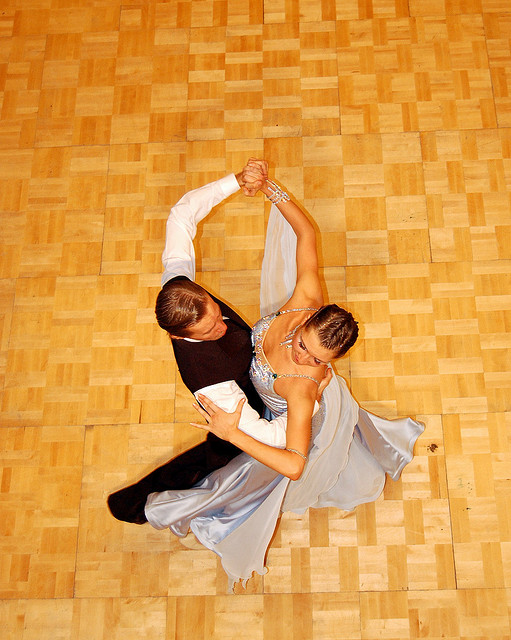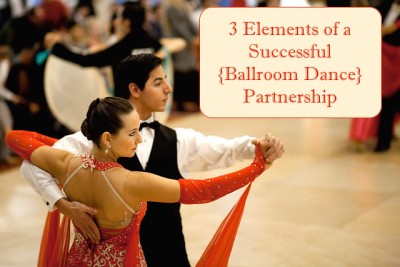Almost every form of dance has some kind of partnering – ballet partnering has been discussed on Dance Advantage before.
But nothing throws you into the deep end of the dance partnership pool like ballroom. Even in your very first group class, you will find yourself face to face with a stranger and offering your hand to them so the two of you can attempt to move as one. Talk about awkward! But it can also be an amazing and unique experience.
There are three key elements needed for a successful partnership, be it in ballroom or another form of dance.
Physical contact.
…whether it’s simply holding hands or pressing your inner thigh against your partner’s.

This contact is no big deal to some people and the world to others. Personal space is out the window in ballroom. And for a woman, the challenge becomes greater when we realize we have to give up personal space AND control, because traditionally in ballroom, the man leads and the woman follows.
When I first started taking ballroom lessons, I found I was able to quickly pick up the steps or the choreography of the dances. Box steps, underarm turns, cross-over breaks? No problem. My problem was waiting for the cue from the man leading me. The timing and overall feel of the dance gets thrown off when the woman moves before the man leads her. The physical contact wasn’t a huge deal for me, at least I didn’t think it was. It’s just dancing after all. But I’ll never forget the group class I took where, when I went into closed position for a tango with the female instructor, she immediately asked me why I was scared. I didn’t think I was tense or pulling away, but she had danced with partners long enough to recognize the more subtle signals my body was sending. And apparently the close contact was setting off internal alarms.
The alarms were related to the second thing partner dancing requires:
Trust.
For me, that is a huge deal. Giving up personal space and control creates a feeling of incredible vulnerability. No one likes feeling vulnerable, especially not me. My life experiences to date have taught me to be strong and take care of myself because I can’t depend on others to always be there. But then here comes ballroom telling me to let go and allow someone else to take care of me, at least while the music is playing. I
am still learning to completely trust my private dance teacher, who is my main dance partner, but I have noticed that every time I let a little bit more of my wall down, our dancing together improves. It takes a lot of trust to dance with a partner, but when it’s there and mutual, the results are beautiful.
Communication.
In ballroom, most of this occurs in the lead/follow. Through the physical contact, the man can signal to the woman what move he wants to do next. Sometimes it is obvious like a raising of the arm to signal an underarm turn, and sometimes it is subtle like the simple shifting of weight to signal a change in direction.
The first two items discussed, physical contact and trust, become critical in creating effective lead/follow communication. No physical connection or a poor connection means lead signals will be lost or misunderstood. A lack of trust will result in a constant struggle between the lead and follow and make effective communication almost impossible.
Communication before and after the actual dancing is just as important as the lead/follow.
Traditionally, in a social setting, a man would offer his hand to a lady and ask if she would like to dance. This invitation creates a friendly and welcoming environment that helps nurture the necessary trust. It also shows respect and allows the woman to give the control, rather than it being taken. This gesture is mimicked on the competition floor as the man extends his hand at the start of the music to invite the woman to dance with him.
After the dance is over, an expression of gratitude, whether a bow or a simple thank you to your partner, completes the experience. I have had partners simply walk away after they danced with me at a social dance to look for their next dance partner, and it soured my whole experience with them, even if it was only one dance. Not a good way to foster trust in me to want to dance with them again. But when a partner would turn to me after the music ended and say thank you and then take my hand to lead me off the dancefloor, I was more than happy to dance with them again, regardless of their skill.

When these three elements of physical contact, trust, and communication come together, the magic of ballroom can be seen.
Two bodies moving as one. Even if the bodies are not in full closed position like you see in waltz or tango, they are still connected and move in response to one another. There is something so satisfying about successfully dancing a ballroom routine with a partner for the first time. It’s like finding those two puzzle pieces that fit together in a 10,000-piece jigsaw puzzle. You can almost hear the click. And you could not have done it without your partner.
As much as I refuse to rely on anyone but myself in life, I am learning to love the partnership that ballroom requires. Because with a good partner, I receive as much as I give and together we are able to create something that would not be possible alone.
 It was through ballroom dance that Katie Harrison started to discover who she really was and what she was capable of, despite the demons of fear, self-doubt, and anxiety that live in her head. She has been taking ballroom dancing lessons since December 2012 and competing in pro-am ballroom competitions since April 2014. Katie started her blog, the Girl with the Tree Tattoo (so named because of the tree of life tattoo that covers her entire back), as a way to share her experiences as an amateur ballroom dancer and connect with other dancers and people in general who are pursuing a passion.
It was through ballroom dance that Katie Harrison started to discover who she really was and what she was capable of, despite the demons of fear, self-doubt, and anxiety that live in her head. She has been taking ballroom dancing lessons since December 2012 and competing in pro-am ballroom competitions since April 2014. Katie started her blog, the Girl with the Tree Tattoo (so named because of the tree of life tattoo that covers her entire back), as a way to share her experiences as an amateur ballroom dancer and connect with other dancers and people in general who are pursuing a passion.

Dance Advantage welcomes guest posts from other dance teachers, students, parents, professionals, or those knowledgeable in related fields. If you are interested in having your article published at Dance Advantage, please see the following info on submitting a guest post. Read posts from guest contributors.

